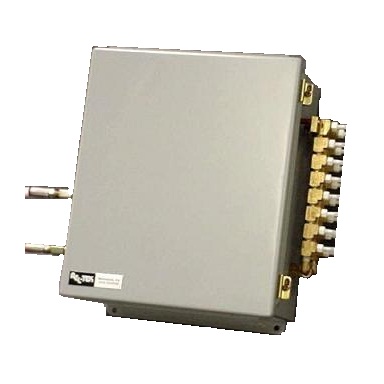MagiKalTM - Automatic Sensor Calibration
ORDER NOW

MagiKalTM,
UnitKal-DX™ and MagiKal II Cuts Sensor
Maintenance Cost!
(UnitKal-DX™ is a smaller version of MagiKalTM system. )
(MagiKal II is a stand-alone unit for automatic calibration.)
Rel-Tek's MagiKalTM system takes the labor out of gas sensor
maintenance. Repetitive and tedious "manual" sensor recalibration
can cost a bundle over the life of a system. It eliminates the costly
labor that is otherwise paid out regularly for manually re-calibrating
an array of gas sensors installed around your garage, plant, lab, tunnel
or mine. MagiKalTM represents a modest extra investment at the outset,
but pays for itself again and again over the years.
To cut the persistent manual calibration cost, Rel-Tek has pioneered in
the development of automatic calibration equipment. The MagiKalTM features
are now built into Rel-Tek's Millennia-DX monitoring and control software.
Recent installations included two municipal vehicle maintenance garages
in Detroit, MI -- one with 32 carbon monoxide sensors and the other with
16 methane sensors.
Automatic calibration runs can be scheduled for slow times, when taking
a group of sensors out of service for 15-20 minutes -- the duration of
a typical automatic calibration run -- is not a problem. The dedicated
MagiKalTM equipment, which is permanently connected to up to 32 gas sensors,
is 100% controlled by the remote monitoring computer. The complete zero/span
calibration of an array of sensors is executed automatically, unattended
and with zero labor.
|
|

MagiKalTM
first disables alarms and then introduces zero and span calibration gas
alternately into each sensor block through an array of distribution tubing.
The computer precisely adjusts the zero and span values to within 1-bit
(1/4096 or +/- .025%) resolution. Large tanks of zero and span cal gas
provide references to NBS accuracy. A single set of tanks can supply gas
for weekly calibrations of a 32-sensor array for a year or more -- a cost
savings, compared with dozens of portable (manual cal) tanks that would
otherwise be needed. Test reports can be printed showing all adjustments
made, while flagging any sensors requiring special attention. Results
are logged to hard disk for archival reference and off-line review. A
graphic screen shows the calibration process.
In the past, figuring 15 minutes of labor for manually calibrating just
one sensor, a facility with 100 sensors could spend 300 man-hours or more
every year for monthly calibrations, easily reaching a $15,000 annual
budget. Now, a MagiKalTM investment can pay for itself in less than
a year.
Besides saving labor cost, MagiKalTM offers other benefits. The tedious
and risky lifts and ladders needed to approach sensors -- usually sited
in hard to reach places -- are avoided, thus eliminating a safety hazard.
And, MagiKalTM avoids the downtime and trouble of shuffling vehicles,
moving stored materials and the like to gain physical access to the sensors,
a costly procedure. Then, too, MagiKalTM avoids the human errors that
usually accompany manual testing. And, if there is ever a question of
sensor accuracy, just key in an extra MagiKalTM run. Or"simply"
set the program to calibrate every day.
Sensors need not all be of the same type, although, at the present, MagiKalTM
processes just one type sensor on each calibration run. For a mix of sensors
-- say, CO, CO2 and CH4 - one set of tanks can usually be custom mixed
to cover all three sensor types. Multiple calibration runs are programmed
to cover all sensor types. MagiKalTM can handle virtually any sensor
array, whether in a cluster or strung out linearly as in a tunnel. Indeed,
upcoming tunnel projects are calling for automatic calibration, because
of the inconvenience and high cost of diverting traffic while recalibrating
manually.
|
|

Rel-Tek's wheel-about "MagiKal TM -WA" scheme can further economize
a large sensor installation. Mounting the cal gas tanks and control panel
on a 4-wheeled cart permits the system to service any number of pre-configured
sensor groups. This eliminates the multiple stationary MagiKal TM units,
but requires someone to reposition the cart, make the two plug-in connections,
and push the start button. The rest is automatic, and the attendant can
leave for a half hour. Panel lights show the calibration process status.
On completion, sensors are automatically returned to operation, and the
threshold alarms and controls are re-activated.
MagiKal TM can easily be retrofitted to an existing Rel-Tek monitoring
installation. Millennia-DX software runs on a PC under Windows-2000 ,
providing integrated data acquisition, remote networking, alarming, controls,
graphics, logging and the like. Compatible field I/O cards assure 100%
data transfer reliability and high speed. Originally developed for the
rigors and multi-mile extent of underground mining, the robust system
represents an integrated plant, lab, tunnel or mine monitoring/control
package -- now including MagiKal TM . Patent is applied for. Hazardous
area approvals are available.
Click here for MagiKal TM
demonstration graph.
|

UnitKal-DX™
UnitKal-DX™ is a small version
of Rel-Tek's MagiKal TM system. MagiKal TM
was developed to calibrate
up to 32 sensors at a time, ideal for above ground applications involving
a large numbers of sensors concentrated in a particular locale. UnitKal-DX,
however, was developed as an economical utility for mining, where sensors
are scattered along a conveyor belt, and where only one or two sensors
are within reasonable cal-gas delivery range.
|
|
We also have Automatic Calibration software and an Extraction calibration system. Check it out.
|
|